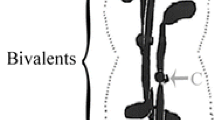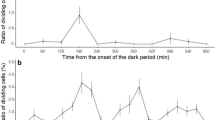Summary
Exposure of germlings of Allomyces neo-moniliformis to colchicine for 0 to 5 min after zoospore encystment was found to block 30% of germlings derived from flagellated zoospores and 55% of germlings derived from deflagellated zoospores in C-metaphase configurations at the first mitotic division. The zoospore lacks a pool of colchicine binding protein, and protein synthesis is absent during the time when colchicine first becomes effective in inducing C-metaphase. From these observations it is concluded that the microtubule subunit protein of the spindle apparatus of the first mitotic division to a large extent is derived from the depolymerization of the cytoplasmic microtubules of the zoospore. GTP, Mg2+, and ATP were observed to be antagonistic to the action of colchicine in vivo. It is suggested that these compounds may compete with colchicine for binding to the subunit protein in vivo. Germlings derived from flagellated zoospores are appreciably less subject to the action of colchicine in the presence of the antagonistic compounds than are germlings derived from deflagellated zoospores. This differential sensitivity to colchicine is interpreted as reflecting a difference in the quantity of microtubule subunit protein present at the time of exposure to colchicine.
Similar content being viewed by others
References
Adelman, M. R., Borisy, G. G., Shelandski, M. L., Weisenberg, R. C., Taylor, E. W.: Cytoplasmic filaments and tubules. Fed. Proc. 27, 1186–1193 (1968).
Borisy, G. G., Taylor, E. W.: The mechanism of action of colchicine-binding of colchicine-3H to cellular protein. J. Cell Biol. 34, 525–533 (1967a).
——: The mechanism of action of colchicine-colchicine binding to sea urchin eggs and the mitotic apparatus. J. Cell Biol. 34, 535–548 (1967b).
Coyne, B., Rosenbaum, J. L.: Flagellar elongation and shortening in Chlamydomonas 11. Re-utilization of flagellar proteins. J. Cell Biol. 47, 777–781 (1970).
Dill, B., Fuller, M. S.: Amino acid immobilization of fungal motile cells. Arch. Mikrobiol. 78, 92–98 (1971).
Deysson, G.: Antimitotic substances. Int. Rev. Cytol. 24, 99–148 (1968).
Fuller, M. S., Calhoun, S. A.: Microtubule-kinetosome relationships in the motile cells of the Blastocladiales. Z. Zellforsch. 87, 526–533 (1968).
—, Olson, L. W.: The zoospore of Allomyces. J. gen. Microbiol. 66, 171–183 (1971).
Inoué, S., Sato, H.: Cell motility by labile association of molecules. The nature of mitotic spindle fibres and their role in chromosome movement. J. gen. Physiol. 50 (Suppl.) 259 (1967).
Olson, L. W.: Microtubule morphogenesis in Allomyces. Ph.D. thesis, Department of Botany, the University of California, Berkeley, California (1970).
—, Fuller, M. S.: Leucine-lysine synchronization of Allomyces germlings. Arch. Mikrobiol. 78, 76–91 (1971).
Rosenbaum, J. L., Carlson, K.: Cilia regeneration in Tetrahymena and its inhibition by colchicine. J. Cell Biol. 40, 415–425 (1969).
—, Moulder, J. E., Ringo, D. L.: Flagellar elongation and shortening in Chlamydomonas J. Cell Biol. 41, 600–619 (1969).
Shelanski, M. L., Taylor, E. W.: Isolation of a protein subunit from microtubules. J. Cell Biol. 34, 549–554 (1967).
——: Properties of the protein subunit of central-pair and outer-doublet microtubules of sea urchin flagella. J. Cell Biol. 38, 304–315 (1968).
Soll, D. R., Sonneborn, D. R.: Zoospore germination in the water mold Blastocladiella emersonii. 11. Influence of cellular and environmental variables on growth. Develop. Biol. 20, 218–235 (1969).
Taylor, E. W.: The mechanism of colchicine inhibition of mitosis. 1. Kinetics of inhibition and the binding of H3-colchicine. J. Cell Biol. 25, 145–160 (1965).
Tilney, L. G.: Microtubules in the asymmetric arms of Actinosphaerium nucleofilum and their response to cold, colchicine, and hydrostatic pressure. Anat. Rec. 151, 426 (1965).
Weisenberg, R. C., Borisy, G. G., Taylor, E. W.: The colchicine binding protein of mammalian brain and its relation to microtubules. Biochemistry 7, 4466–4479 (1968).
—, Timasheff, S. N.: Aggregation of microtubule subunit protein. Effects of divalent cations, colchicine and vinblastine. Biochemistry 9, 4110–4116 (1970).
Wilson, L.: Properties of colchicine binding protein from chick embryo brain. Interactions with vinca alkaloids and Podophyllotoxin. Biochemistry 9, 4999–5007 (1970).
Author information
Authors and Affiliations
Rights and permissions
About this article
Cite this article
Olson, L.W. Colchicine and the mitotic spindle of the aquatic phycomycete Allomyces . Archiv. Mikrobiol. 84, 327–338 (1972). https://doi.org/10.1007/BF00409081
Received:
Issue Date:
DOI: https://doi.org/10.1007/BF00409081




